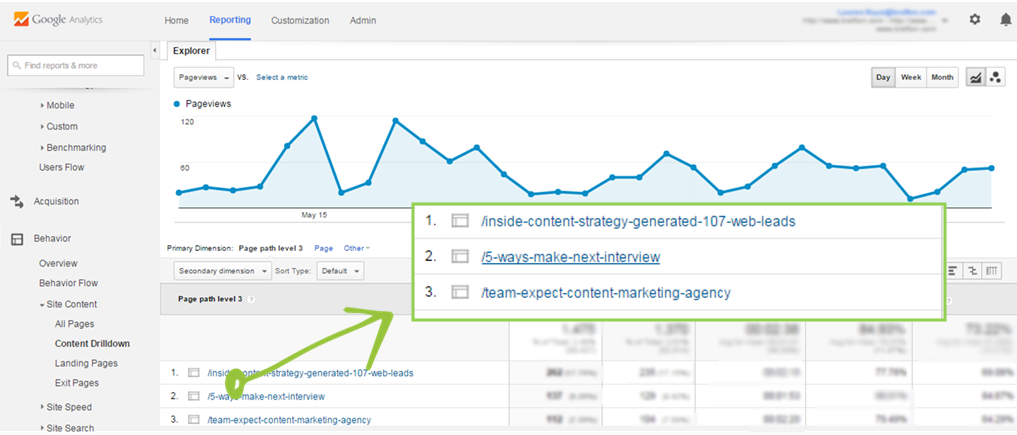For a content marketing strategy to be successful, it needs to be underpinned by data. After all, if it’s not informed by something tangible, then it’s probably not doing a whole lot to drive sales, increase your audience or anything else positive.
As a writer and editor, I use Google Analytics to refine my approach based on hard numbers about what the audience is responding to.
There’s a reason research firm Gartner called information and analytics the oil and combustion engine of this century.
There are many tools out there to help you gather information related to your marketing efforts and understand what’s working, but we here at Brafton swear by Google Analytics. It’s tailor made for showing us everything we might want to know about a website, and it’s totally free to use.
Everyone from content marketing strategists to writers can use this critical tool every day to learn what is bringing in eyeballs, keeping visitors engaged and driving conversions.
Step 1: Set clear expectations, then establish a baseline
Before ever opening up your Google Analytics account, it’s helpful to know what you you want to measure.
As an editor, my first step is to conduct a competitive analysis to see what some others in an industry are doing:
- How does your site compare to what industry leaders and laggards are doing online?
- What topics are others writing about?
- What kinds of visuals do they use?
These kinds of insights can let you know about what your audience likely will or won’t like to see on your website. I’m a big baseball fan – go White Sox! – so I’d like to use an analogy here.
Let’s say you have tickets to see the top pitcher on your favorite team go up against a rival one Sunday afternoon. What can you expect to see from the pitcher? Is this player likely to have a good outing or a bad outing? Will your team be competitive or not? Will the pitcher throw mostly fastballs or curveballs?
While you have no way of knowing for certain what will happen, you can make some basic assumptions if you know a little bit about the players and teams involved before the game.
Don’t produce content blind – establish a baseline to set expectations.
This same principle applies to content marketing. Don’t produce content blind – rather, establish a baseline to set expectations. Google Analytics provides a quick snapshot of how a site overall has been performing for the last three months, year, or however long you want to check info on:
- How many people are coming to your site
- What they’re doing when they’re there
- How long they stick around
Consider this your true foundation. You can then easily compare that data with another time period, to see how the site overall has been changing over time. This data helps you set expectations for when it’s time to really dive into your written pieces.
If the majority of website visitors stick around for three minutes on average, let’s say, then I know a blog with an average time on site of 30 seconds is not catching on.
Step 2: Determine which goals & metrics are most important
Google Analytics has a lot of information, but likely not everything is going to useful to you.
Before getting in too deep with your analysis, take a moment to consider what exactly you want to achieve with the content writing and what associated metrics would help you reach that goal.
If you are primarily concerned with getting more people onto your website, then statistics related to traffic will be especially important to you, such as:
- Impressions
- Number of new visitors
- Percent of all traffic from new visits
However, if you’re mostly concerned with engagement, then these kinds of stats will be most important for you:
- Average user time on site
- Average session duration
- Average number of pages seen per visitor
Step 3: Take a deep dive into the top posts
Now it’s time for the fun stuff. Assuming you have a good breadcrumb URL structure that allows you to separate your content marketing work (like a blog for example) from the rest of the site, and it displays most of the headline the URL, you should be good to go.
With this set up, you can quickly and easily determine which blog posts are performing the best for your site, per your pre-established goals.
I usually first look for the ones bringing in the most traffic- and consider what might have lead to a piece’s success, including:
The headlines
- What commonalities can you find in the top performers?
- Do they include questions, stats, sensational statements or clever language?
See if longer or shorter headlines bring in more people and monitor how use of punctuation or numbers affect traffic. Sometimes just saying “easy” instead of “simple” in a headline can make a major difference.
The categories
- Are there specific subject areas doing better than others?
- Is there a single category that gets more coverage than others – and is it driving the most traffic?
- Is there a category that gets less coverage, but generates more visits for your site?
Readers might be more interested in certain product categories, and you can make a bigger impact with your audience by providing stronger coverage of these highly sought after topics.
The keywords
- What key terms or phrases are bringing in the most visitors?
- Are long-tail keywords or branded terms driving more traffic?
If you can identify the search terms that resonate with people who are looking for information about your business, you can tailor your writing to speak the same language as your readers.
Content marketing is like a baseball game, not a sumo wrestling match. It doesn’t happen in an instant, and you may not see serious results immediately.
After I analyze these initial factors, I can take a closer look at the posts to see how other editorial choices might be impacting success:
The hook
- What does the opening paragraph read like on the top performing posts?
- How is it different from posts that got fewer hits and lower engagement?
- You only have a short amount of time to capture someone’s attention, and a poorly worded introduction can ruin even the best article.
The length
- How long is the article?
- Is it a short piece with just the facts, or is it 1,000 words or longer with substantial exposition and quotes?
- Although readers’ attention spans are shrinking, there’s data that supports longer articles rank better and outperform short pieces online. Plus, everyone’s audience is different.
The visuals
- What is the picture choice?
- Does it use a lot of bright colors, or is it subtle?
- What’s the subject, and how is it shot? I’ve found that for some clients, using a picture without a human in it can keep readers on the site reading articles for longer.
- Are there multiple subheads throughout the piece, and what are they accomplishing?
- Are they funny (lending themselves to the narrative or theme) or do they tease out the facts coming in the next section?
Make some notations about the features in the top performing posts to see what commonalities they have. Build out a template of what you find and use it to frame future blog posts. If there’s discrepancy or variety, use these differing ideas to A/B test content writing approaches.
I like to make a running checklist of the commonalities of some of the top performing posts, and then I’ll keep that open as I write a new piece to make sure I’m keeping everything in mind.
Step 4: Give yourself time to see if everything is working well
To stick to my sports analogy, content marketing is like a baseball game, not a sumo wrestling match. It doesn’t happen in an instant, and you may not see serious results immediately.
More often than not, you’ll see tangible results after you’ve been blogging for six to 12 months. Be patient, persistent and data-oriented with your content marketing – and you’ll see positive ROI.
When it comes to content marketing, analytics can’t replace creativity.
You still need a content writer to come up with interesting ideas and convey them in a way that captures readers’ attention and makes them want to learn more. But, by using analytics to help you gain a better understanding of what has worked in the past, you can be sure that every piece of content you create in the future is fine-tuned for success.







